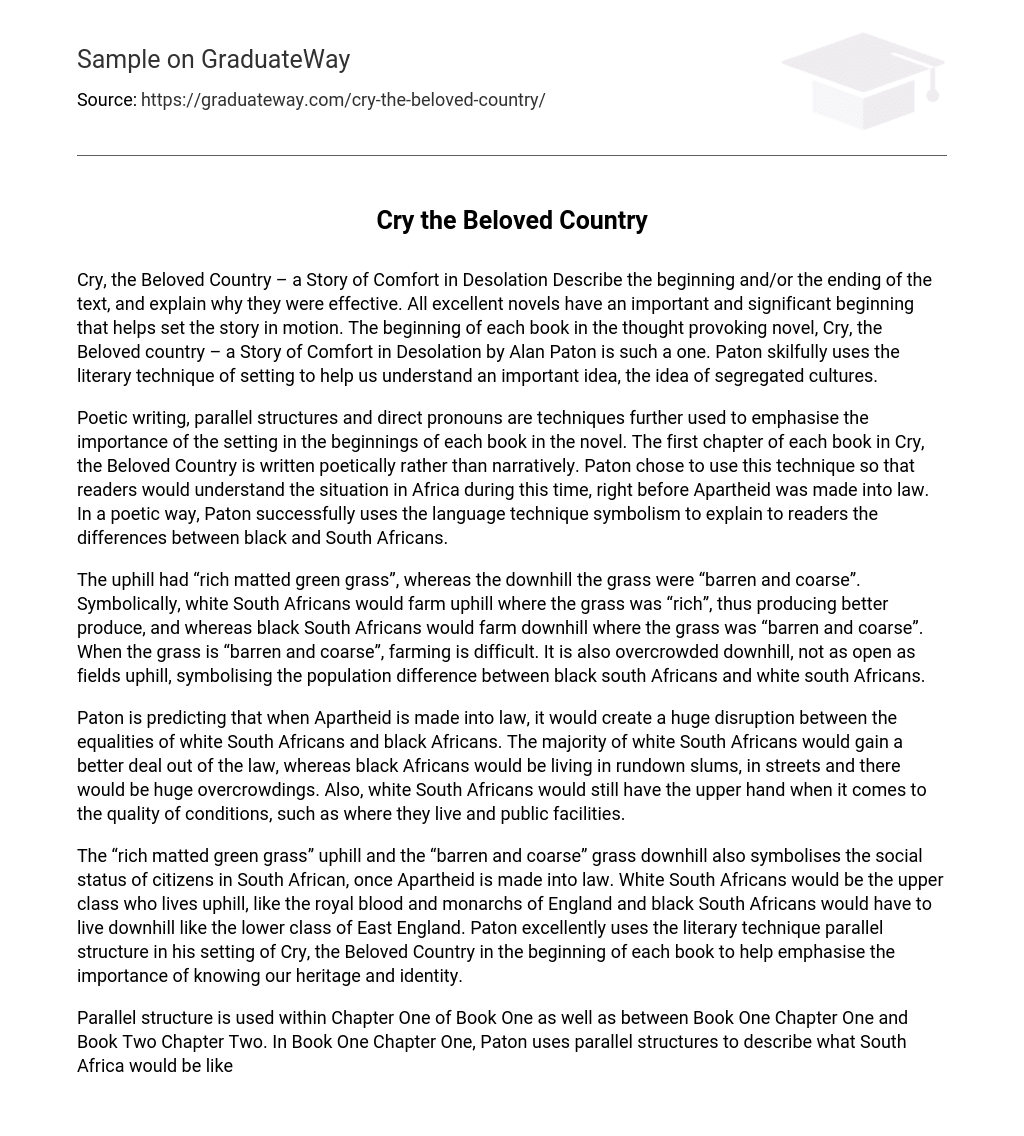Cry, the Beloved Country – a Story of Comfort in Desolation Describe the beginning and/or the ending of the text, and explain why they were effective. All excellent novels have an important and significant beginning that helps set the story in motion. The beginning of each book in the thought provoking novel, Cry, the Beloved country – a Story of Comfort in Desolation by Alan Paton is such a one. Paton skilfully uses the literary technique of setting to help us understand an important idea, the idea of segregated cultures.
Poetic writing, parallel structures and direct pronouns are techniques further used to emphasise the importance of the setting in the beginnings of each book in the novel. The first chapter of each book in Cry, the Beloved Country is written poetically rather than narratively. Paton chose to use this technique so that readers would understand the situation in Africa during this time, right before Apartheid was made into law. In a poetic way, Paton successfully uses the language technique symbolism to explain to readers the differences between black and South Africans.
The uphill had “rich matted green grass”, whereas the downhill the grass were “barren and coarse”. Symbolically, white South Africans would farm uphill where the grass was “rich”, thus producing better produce, and whereas black South Africans would farm downhill where the grass was “barren and coarse”. When the grass is “barren and coarse”, farming is difficult. It is also overcrowded downhill, not as open as fields uphill, symbolising the population difference between black south Africans and white south Africans.
Paton is predicting that when Apartheid is made into law, it would create a huge disruption between the equalities of white South Africans and black Africans. The majority of white South Africans would gain a better deal out of the law, whereas black Africans would be living in rundown slums, in streets and there would be huge overcrowdings. Also, white South Africans would still have the upper hand when it comes to the quality of conditions, such as where they live and public facilities.
The “rich matted green grass” uphill and the “barren and coarse” grass downhill also symbolises the social status of citizens in South African, once Apartheid is made into law. White South Africans would be the upper class who lives uphill, like the royal blood and monarchs of England and black South Africans would have to live downhill like the lower class of East England. Paton excellently uses the literary technique parallel structure in his setting of Cry, the Beloved Country in the beginning of each book to help emphasise the importance of knowing our heritage and identity.
Parallel structure is used within Chapter One of Book One as well as between Book One Chapter One and Book Two Chapter Two. In Book One Chapter One, Paton uses parallel structures to describe what South Africa would be like once Apartheid is made law. Land is very important to everyone as it represents one’s roots and heritage. So when Paton says “keep it, guard it, care for it, for it keeps men, guards men, cares for men”, in paragraph two, the ‘it’ represents the land.
However, if the land is not “kept, or guarded, or cared for, [then] it no longer keeps men, guards men, cares for men”, as described in paragraph three. This parallel structure used between the two paragraphs whilst describing the setting is important as it describes that it is because of the loss of roots that the younger generation has become last and not enlightened. Similarly this idea can be comprehended by the enslavement of Africans shipped to America during the 19th Century.
These Africans who have been forced to become slaves against their will have lost their roots as new generations are born and are lost in their place in society nowadays, which inevitably led to the Black Civil Rights Movement in America. Paton is emphasising that if we destroy the land then man in turn is destroyed. Parallel structure is also used in the beginning of chapter one in Book One and Book Two. The first two paragraphs are identical in both books. Paton deliberately did this to show that both Stephen Kumalo and James Jarvis start at the same place in their journey of enlightenment.
They are the same in where they live, they are simple and honest men, and they are both married and have one son who they love very much. Both men are confronted by the same tragedy and find strength to move on by spreading “love” and “hope”. The only difference that stands out is that of their race. In the first chapter of Cry, the Beloved Country, Paton deliberately uses direct pronoun to make readers think. He tells readers that “where you stand, the grass is rich and matted, you cannot see the soil”.
The ‘you’ is deliberately used to make readers take a step back and question, “yes where we stand is all nice and perfect, but isn’t everyone like this? ” Paton makes readers think of others, to move out of our comfort zone and sympathise with others who do not have the same luxuries, through the use of direct pronoun. He provokes readers to think of the poor black South Africans, and the likes of the black Americans whose heritage has been lost through the thoughtlessness of their captors, and of the Aborigines whose land has been forcibly taken away from them.
The idea of a segregated culture is significantly developed and explored by Paton in the setting of the beginning of each book in the critically acclaimed novel, Cry, the Beloved Country – a Story of Comfort in Desolation. Segregated cultures will tear apart their society as a whole, and inequality will be brought about. The beginning of the novel is important as it sets the problems in motion. After all, inclusion, not exclusion, is the key to survival.





